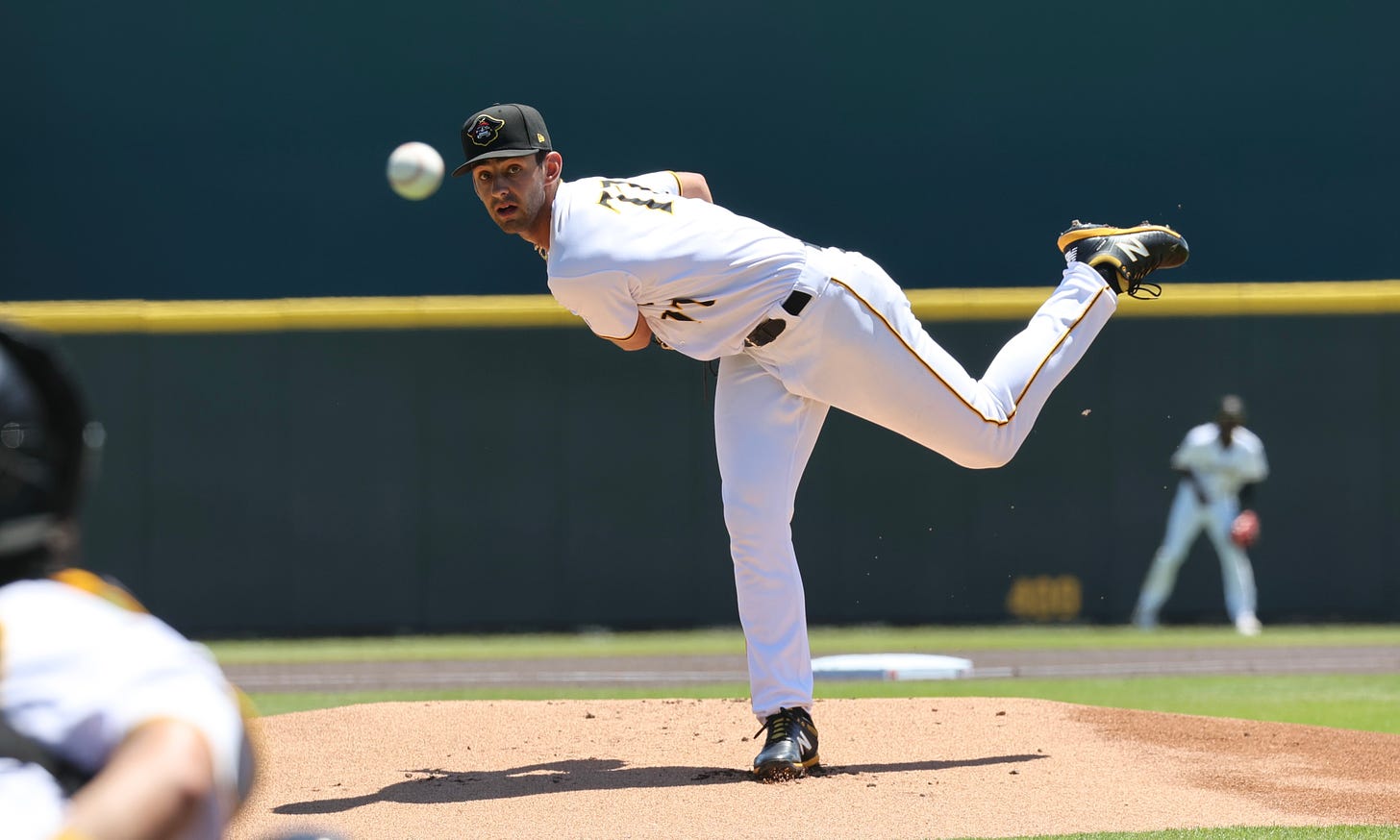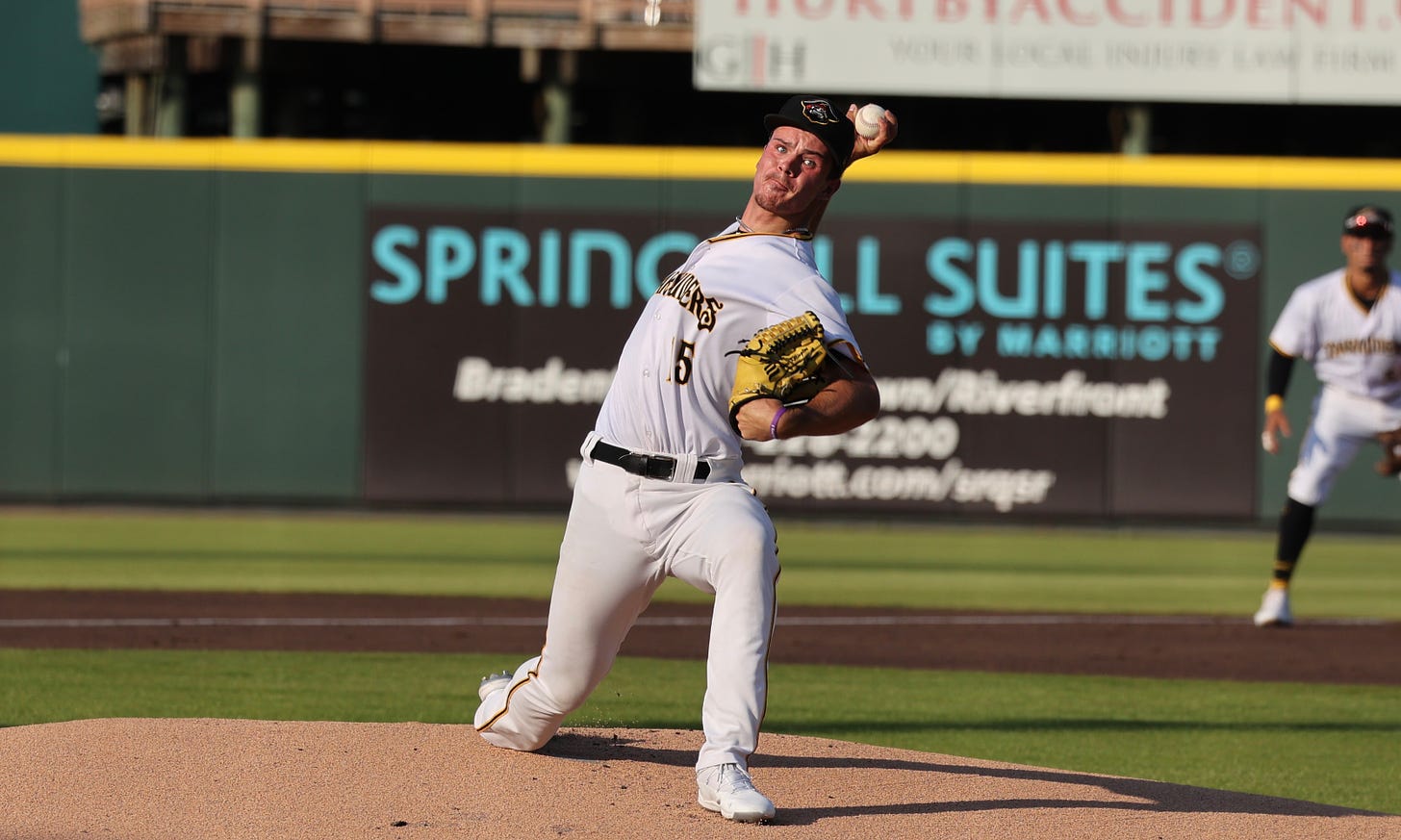Pirates See Starters Making Some Progress at Bradenton, Part 1
Well . . . off and on at least . . . .
The Bradenton Marauders have had some turnover in their starting rotation this year. Thomas Harrington, J.P. Massey and Derek Diamond all got promoted to Greensboro. Some new guys have joined the show: Hung-Leng Chang, Hunter Barco and Drake Fellows have all moved up from the Florida Complex League, the latter two after brief rehab stints. And Luis Peralta has shifted between starting and long relief.
Four starters, though, have been constants for most of the year: Owen Kellington, Dominic Perachi, Wilber Dotel and Alessandro Ercolani. They’ve all made a relief appearance or three, generally after somebody on rehab pitched an inning or two. Ercolani is currently on the 7-day injured list and Dotel had a stint there early in the year. But generally they’ve stayed in the rotation.
None of the four is lighting the woods on fire. Dotel sports a 2.40 ERA, but his other numbers are less impressive. The other three have ERAs between 4.22 and 4.43, which oddly is a very narrow range. That’s better than it looks. The Florida State League average is 4.57, far above historical norms, most likely due to rapidly ballooning walk rates.
All four of these pitchers have strengths that could help them move forward, and in all four cases those strengths are surfacing at times. Arguably, those times are becoming more frequent as the season goes along. This is a look at the four, in two parts, starting with Perachi and Kellington. (Spoiler alert: I find Dotel and Ercolani the more interesting of the four.)
One quick note: StatCast data is available for most FSL games, including all the ones at LECOM Park in Bradenton. I don’t entirely trust the pitch classifications, though. Without going into detail, I’ve seen enough anomalies (I’ll discuss this briefly with Dotel) that I especially don’t trust the system’s characterizations of four-seam fastball vs. sinker and curve vs. slider, among others.
Dominic Perachi
An 11th round draft pick in 2022, Perachi checks a lot of boxes for the Pirates. They seem to prefer going off the beaten path for college pitchers, and Perachi, who hails from Australia, went to Salve Regina University. They also pay a great deal of attention to college summer leagues and Perachi did well in the New England Collegiate Baseball League in 2022. And, the Pirates like high-spin breaking balls. Perachi features two, which are either two curves thrown from different angles, if you go by the scouting reports, or a curve and a slider if you go by StatCast. On either, the spin rate runs between 2600 and 2800 rpm, or even higher occasionally — very good numbers.
One other thing Perachi has in common with a lot of the Pirates’ college pitching draftees: His fastball velocity doesn’t match the draft-time scouting reports. Supposedly 93 mph, he’s averaged about 89 as a pro.
Perachi didn’t pitch last year and his 2023 season has had ups and downs. He struggled through three April starts, with a 2.06 WHIP in three starts. He pitched mostly well in May and July, not so well in June, when he had some gopher ball issues. (His one August outing so far was a bad one.)
Perachi’s three main pitches are a four-seam fastball, a slider and a curve. He throws a change occasionally but it hasn’t been a big part of his game. For much of the year, he typically threw the fastball about half the time and the curve around a quarter or more, with the slider a distant third. His last couple games, if you accept the StatCast breakdown, he started throwing the slider more than the curve.
The crux of Perachi’s game at this point is getting hitters to chase. He doesn’t throw any of his pitches for strikes a lot; even the fastball often is in the strike zone just a third of the time or so. When Perachi is able to get hitters to chase the fastball out of the zone 30-40% of the time, he can be very successful with it, getting a lot of swings and misses as well as a lot of called strikes.
For instance, on July 29, Perachi fanned ten and allowed just one run over six and a third innings. (Drake Fellows actually started that game but threw just an inning.) Hitters chased the fastball out of the zone 36% of the time and whiffed on it in 28% of their swings. That probably made his slider more effective, as hitters whiffed on it 60% of the time. Observationally, I’ve seen Perachi throw high fastballs past hitters even though the velocity isn’t great. I’d guess the hitters are strugging to decide whether they getting a fastball or breaking ball.
If Perachi isn’t getting hitters to chase, it doesn’t go so well. On August 4, Tampa hitters chased the fastball only 14% of the time and whiffed on it on only two of 17 swings. They also whiffed on sliders and curves only four times in 11 swings. The end result was seven hits and four walks in 3.2 IP.
So far, Perachi has been able to make his approach work more often than not. I’m skeptical, though, whether it’ll work at higher levels. Without throwing the fastball for strikes more and getting ahead in the count, he may not be able to use the breaking stuff as effectively.
Owen Kellington
Kellington was a fourth-round draft pick in 2021, signing for a little over slot out of prep school in Vermont. He didn’t pitch that year. He left his second outing in 2022, in the FCL, with a hamstring injury. On the season he threw just ten innings and had a very rough time. This year, the Pirates sent Kellington to Bradenton to open the season and he’s been in the rotation since late April.
Kellington relies mainly on three pitches: a four-seam fastball, curve and change. Depending on how much you credit StatCast, he also occasionally throws a slider and maybe a cutter. Typically, he’ll throw the fastball a little over 40% of the time. The velocity probably isn’t what the Pirates hoped when they drafted him, generally just a hair over 90 mph.
The more interesting pitches are the curve and change. The curve has been Kellington’s go-to pitch. He’s usually thrown it about a quarter to a third of the time. He gets even more spin than Perachi, over 2800 rpm. It’s a good but not overwhelming swing-and-miss pitch. The change is one that he started using more at the end of July. In his last two starts (which, as I write this, were July 28 and August 3), he’s thrown it almost as much as the curve. It’s produced nine misses on 16 swings.
Throwing strikes is less of an issue for Kellington than it is for Perachi. Where he’s had trouble is putting hitters away. That’s leading to some high pitch counts, with the result that he has yet to go past four innings. In his last seven starts, he’s gone three to four innings each time, with a pitch count ranging from 55 to 72. So he’s averaging 15-20 pitches per inning, which means there’ve been some long innings.
For most of the year, Kellington has pitched well, the big exception being June, when he had an ERA of 6.00 and a WHIP of 1.75. Walks were the main problem; between May and June, he walked 23 in 28.2 IP. Since then, he’s cut that to eight in 18.2 IP. He’s also fanned 25 in those 18.2 IP.
The bottom line with Kellington is that he’s going to need to go forward as a finesse guy, unless his velocity picks up. That could certainly happen. He has the size and build for it, and he won’t turn 21 until next February. Considering that he’s a prep draftee who got into only ten innings before this year, and he’s now in full-season ball, his command is reasonably good. As a finesse pitcher, he’ll need to continue improving it and he’ll need the change as a third pitch.






Skenes’ first pitch broke the bat in half.
Possibly in the near future, I'm probably going to expand into some more analytically driven viewpoints with some metrics I'm looking into more. Cause I'd say it at least gives more insight into maybe why they're seeking players that on the surface come across as kind of "meh".